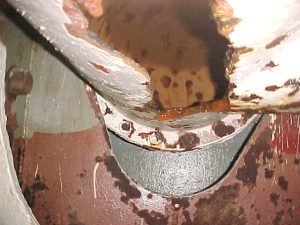The Charity
Aviation
Maritime
Engine Room Flood

Initial Report
Report Text:
A vessel was conducting ballasting operations concurrent with discharging cargo. The vessel is equipped with steel ballast pipe work installed in a ring main configuration.
The Chief Officer had joined the vessel as an emergency relief and had recently received the handover from an experienced Master. This was his first trip on this class of vessel.
During the early stages of ballasting, the Chief Officer was concerned that the ballasting operation was falling behind and would not be completed in time for the vessel’s departure – and so a second ballast pump was started at this request. This was a deviation from approved operating procedures and was not discussed with the Master or Chief Engineer. However, ballasting operations were completed well before the completion of discharge. With adequate time in hand a decision was taken to educt a cofferdam that had approximately 90cm of water in it. This was a further deviation from approved operating procedures.
On completion of educting operations, the ballast main was filled directly from No. 1 ballast tank (forward from most tanks) which contained water to a depth of between 10 -15 metres. Line filling was achieved by opening the butterfly valves that have no positioning function, i.e., can only be 100% open or 100% closed. The vessel was trimmed by the stern at this point.
The opening of No. 1 ballast tank valves resulted in water quickly entering the ballast pipe work. When the quickly moving body of water ‘hit’ the first closed line block valve, a pressure surge (water hammer) occurred that damaged an adjacent section of Engine Room pipe work. The bottom section of a T-piece was forcefully ejected from the pipe work and resulted in an opening approximately 800m x 300mm.

The Engine Room flooded to a depth of 1.1m in approximately 10 minutes. The engineering team promptly manned the Engine Room and efficiently implemented emergency procedures. Emergency bilge injections were immediately brought into action using two separate pumps and water levels reduced to a safe depth.
Close Out Actions:
- Operating procedures are to be reviewed to ensure reference is made to the care needed when filling ballast pipelines. If necessary, procedures should be amended in accordance with the change management procedures appropriate to the Fleet Group in question.
- Handover requirements have been revised for personnel new to the class of vessel concerned.
- The cargo-handling manual will be updated to give clear and concise guidance on how to refill evacuated ballast lines.
Key Learnings:
- Deviations from approved ballasting procedures must first be discussed with the Master and / or the Chief Engineer.
- Evacuated ballast lines must be refilled from a low-pressure source in a controlled manner.
- Personnel new to a class of vessel must be made aware of the limitations of the ballast system.
- Effective and urgent implementation of emergency Engine Room procedures is necessary if machinery damage is to be avoided.







